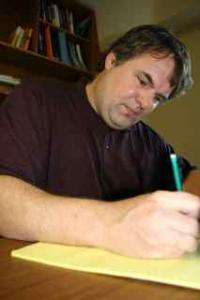Building mathematical models for cancer treatments

(PhysOrg.com) -- South Dakota State University mathematicians are helping doctors of the Mayo Clinic build mathematical models to fine-tune an innovative strategy to treat cancer.
South Dakota State University mathematicians are helping doctors of the Mayo Clinic build mathematical models to fine-tune an innovative strategy to treat cancer.
Assistant professor Matt Biesecker from SDSU’s Department of Mathematics and Statistics said the project has to do with Mayo Clinic Cancer Center physicians’ plan to use a modified measles virus against some forms of cancer. That new line of attack against cancer is possible because Mayo researchers used bioengineering techniques to make a modified measles virus that will preferentially infect cancer cells instead of the cells the virus would ordinarily target.
Biesecker said SDSU scientists aren’t involved in Mayo physicians’ laboratory work with the virus. The SDSU role so far has been helping Mayo researchers’ adjust their working mathematical model to simulate treatment plans. That work can help Mayo scientists figure out timing of treatments, for example, and how large or small doses of virus affect the growth of tumors.
Biesecker said the model was based a system of ordinary differential equations, where the tumor cells and viruses are viewed as homogeneous populations and thus did not account true interactions between viruses and cancer cells at the molecular level. On the other hand, the model provided a good fit to experimental data.
“What we have been working on is a more complicated and more accurate mathematical model. It would take into account the multiple spatial scales that are involved. Viruses are very small in scale compared to the size of the tumor cell. The current model does not take that into account.”
Biesecker and his colleagues wrote about the project in a journal article published in late 2009 in the Bulletin of Mathematical Biology. His co-authors are assistant professor Jung-Han Kimn, also of SDSU’s Department of Mathematics and Statistics; professor Huitian Lu of SDSU’s Department of Engineering Technology and Management; David Dingli of the Mayo Clinic’s Department of Molecular Medicine; and Zeljko Bajzer of the Mayo Clinic’s Biomathematics Resource Core in its Department of Biochemistry and Molecular Biology.
The mathematical model could help the Mayo researchers in the process of designing viruses to target cancer. For example, having a more detailed mathematical model could help scientists understand how likely a particular virus is to infect a tumor cell versus a normal cell, how quickly the virus would replicate within an infected cell, and how quickly an infected cancer cell would die.
“There are certain key characteristics the Mayo researchers want their viruses to have,” Biesecker said. “What mathematical modeling has allowed them to understand is which of these characteristics plays a dominant role in reducing the tumor cell population. Ultimately their goal is to find an effective treatment. It’s not just an intellectual exercise.”
In the published study, Biesecker and his colleagues started with a model of the dynamics of tumor virotherapy, validated with experimental data, then used “optimization theory” to examine possible improvements in tumor therapy outcomes. The scientists found that in most circumstances, giving more than two doses of a virus is not helpful; correctly timed delivery of the virus provides far better results when compared to regularly scheduled therapy or continuous infusion; and a second dose of virus that is not properly timed leads to a worse outcome compared to a single dose of virus.
Surprisingly, the model also predicts that it is less costly to treat larger tumors than small ones. Scientists are still trying to determine why. Biesecker said though the results are counter-intuitive, the finding makes sense in light of the fact that the therapy is trying to infect a community of cancer cells with a virus. A denser population of target cells makes it more likely for the infection to take hold and spread.
In the next mathematical model, Biesecker said, SDSU scientists hope to simulate the behavior of individual cells, giving Mayo scientists greater insight into how viruses can be used against cancer.
Provided by South Dakota State University















